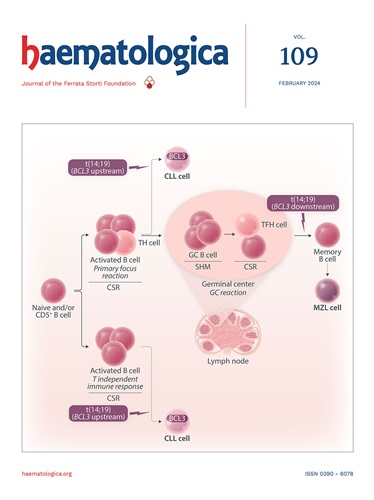Early detection and management of extracranial arteriopathy reduces the incidence of silent cerebral infarcts in sickle cell anemia: a long-term prospective cohort study.
IF 7.9
1区 医学
Q1 HEMATOLOGY
引用次数: 0
Abstract
Previous reports about the Creteil newborn-cohort (1988/Apr-2007) showed that the risk of silent cerebral infarcts (SCI) remained high (37.1%) by age 14 in children with sickle cell anemia (SCA) and intracranial time-averaged mean maximum velocity (TAMMV)≥200cm/s despite chronictransfusion. Systematic assessment of extracranial internal carotid artery (eICA) since June-2011 revealed that SCI-risk is associated with chronic or acute anemia and eICA-stenosis. Based on these results, SCA-children with eICA-TAMMV≥200cm/s or eICA-stenosis were placed on chronictransfusion and considered for allogeneic stem-cell transplantation (alloSCT). SCA-children with 160-199cm/s eICA-TAMMV were maintained on hydroxyurea. We hypothesized that detection/management of eICA-arteriopathy and wider use of hydroxyurea could reduce SCI-incidence. Comparison between the new cohort (May-2007/Dec-2014) eICA-assessed before age 4 with wider but not systematic use of hydroxyurea and the earlier cohort (1988/Apr-2007) never eICAassessed until the 2008 update, revealed a significant reduction of SCI-risk (Log-Rank, P=.009) associated with eICA-assessment but not with wider use of hydroxyurea. eICA-TAMMVs≥160cm/s, even with no eICA-stenosis, were risk-factors for SCI, suggesting that all SCA-children with eICATAMMV≥ 160cm/s should be placed on chronic-transfusion. Hydroxyurea initiation at an early age was associated with lower intracranial-arteriopathy incidence, but not with lower eICA-arteriopathy and SCI-incidence. In the overall cohort (1988-2014), including 332 SCA-children, all assessed/managed for eICA-arteriopathy after 2011, the cumulative-SCI-incidence by age 14 was 25.0% (95%CI:19.0%-31.0%). SCI-risk was associated with being older at first-neck-MRA and having high MCV on hydroxyurea. While the impact of hydroxyurea on SCI-incidence remains unclear, making controlled trials necessary, eICA-arteriopathy management by intensive therapy is effective at improving SCIprevention.颅外动脉病变的早期发现和治疗可降低镰状细胞性贫血患者无症状性脑梗死的发生率:一项长期前瞻性队列研究
先前关于Creteil新生儿队列(1988/ 4 -2007)的报道显示,镰状细胞性贫血(SCA)患儿在14岁时发生无症状性脑梗死(SCI)的风险仍然很高(37.1%),尽管慢性输血,但颅内时间平均平均最大流速(tammm)≥200cm/s。2011年6月以来对颅外颈内动脉(eICA)的系统评估显示,sci风险与慢性或急性贫血和eICA狭窄相关。基于这些结果,对eica - tammm≥200cm/s或eica -狭窄的sca -儿童进行慢性输血,并考虑进行同种异体干细胞移植(allogeneic stem cell transplantation, alloSCT)。用羟基脲维持160 ~ 199cm/s eICA-TAMMV的sca患儿。我们假设eica动脉病变的检测/治疗和羟基脲的广泛使用可以降低sci的发病率。新队列(2007年5月/ 2014年12月)在4岁前进行eica评估,并广泛但不系统地使用羟基脲,而早期队列(1988年/ 2007年4月)直到2008年更新才进行eica评估,结果显示,与eica评估相关的sci风险显著降低(Log-Rank, P= 0.009),但与羟基脲的广泛使用无关。eICATAMMV≥160cm/s,即使没有eICATAMMV狭窄,也是发生脊髓损伤的危险因素,提示所有eICATAMMV≥160cm/s的sca患儿均应进行慢性输血。早期开始使用羟基脲与较低的颅内动脉病变发生率相关,但与较低的eica动脉病变和sci发病率无关。在整个队列(1988-2014)中,包括332名sca儿童,所有儿童在2011年之后都接受了eica动脉病变的评估/治疗,14岁时累积的sci发病率为25.0% (95%CI:19.0%-31.0%)。sci风险与首次颈部mra年龄较大和羟基脲MCV高有关。虽然羟基脲对sci发病率的影响尚不清楚,因此有必要进行对照试验,但通过强化治疗来管理eica动脉病变对改善scii预防是有效的。
本文章由计算机程序翻译,如有差异,请以英文原文为准。
求助全文
约1分钟内获得全文
求助全文
来源期刊

Haematologica
医学-血液学
CiteScore
14.10
自引率
2.00%
发文量
349
审稿时长
3-6 weeks
期刊介绍:
Haematologica is a journal that publishes articles within the broad field of hematology. It reports on novel findings in basic, clinical, and translational research.
Scope:
The scope of the journal includes reporting novel research results that:
Have a significant impact on understanding normal hematology or the development of hematological diseases.
Are likely to bring important changes to the diagnosis or treatment of hematological diseases.
 求助内容:
求助内容: 应助结果提醒方式:
应助结果提醒方式:


